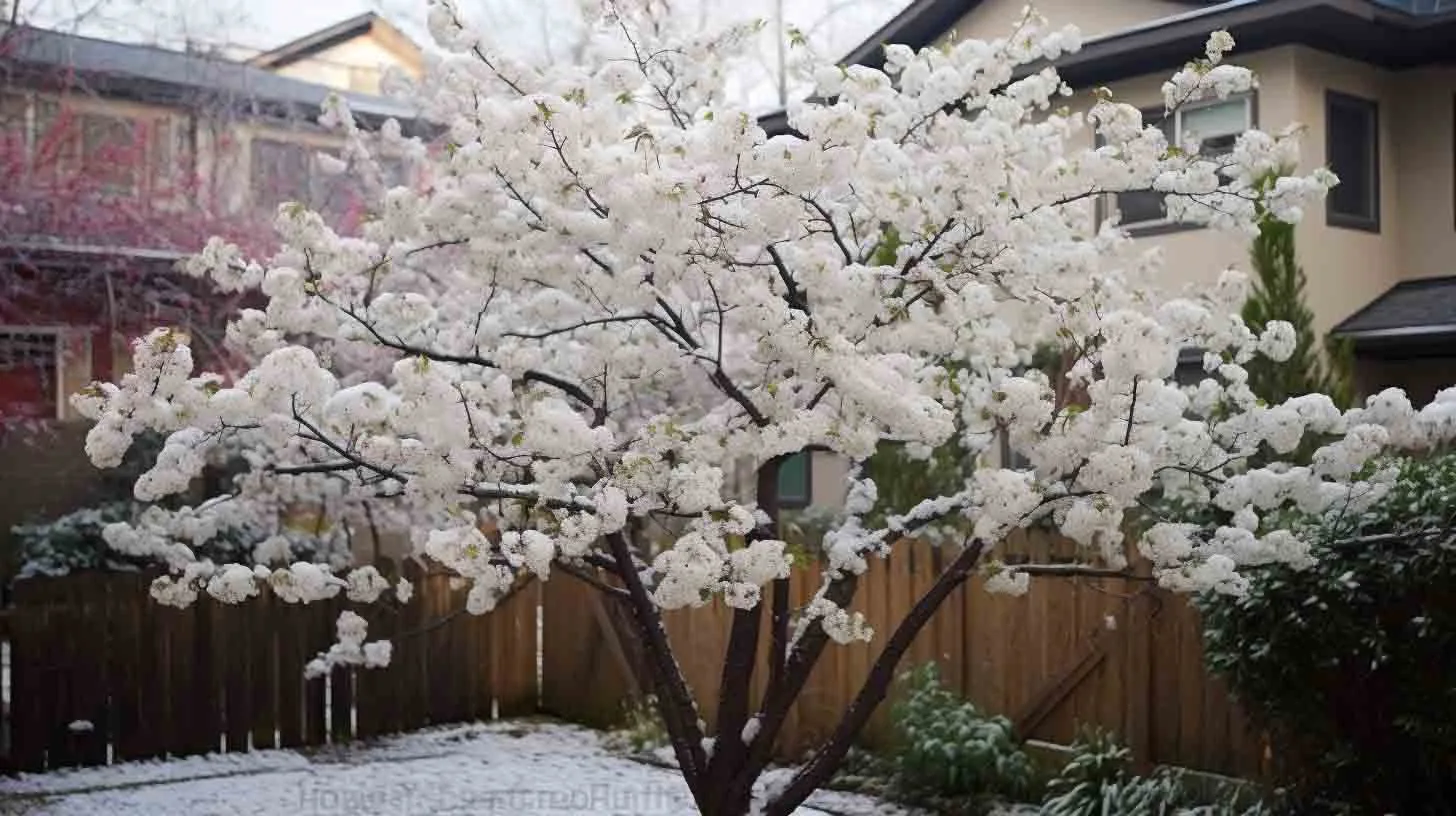If you live in Texas, you know our seasons don’t play by the rules. One day it’s 70 degrees, the next it’s 102 and dry as toast.
That’s why choosing flowering trees that thrive in Texas isn’t just a good idea, it’s necessary.
And if you’re anything like me, you want trees that not only survive but put on a show all year long.
So, I’ve put together this list of my absolute favorite flowering trees for Texas yards, trees that laugh in the face of heat, bloom like wild, and make your yard the prettiest one on the block.
Let’s get right into it.
Why Flowering Trees Are a Must for Texas Yards
Planting flowering trees isn’t just about pretty petals. These beauties do way more than just look good
- They bring shade, vital in a Texas summer when the sun’s doing overtime
- They attract pollinators like bees, butterflies, and hummingbirds, which makes your whole garden happier
- They add serious curb appeal without needing a full landscaping overhaul
Honestly, I treat flowering trees as the anchor pieces of my outdoor space. Once they’re in place, everything else falls into rhythm, shrubs, flowers, mulch, you name it.
1. Crape Myrtle
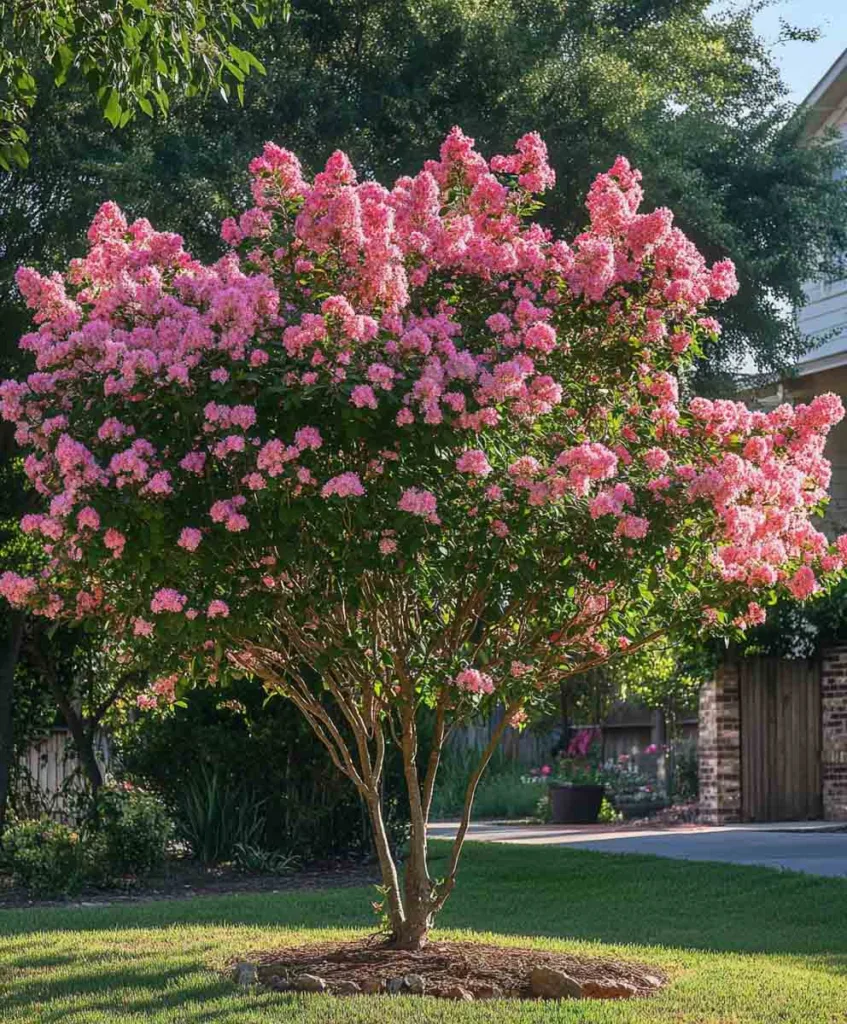
These trees are practically celebrities in Texas neighborhoods.
I’ve got one in my front yard, and it blooms so long, I swear it gets tired. You’ll get months of flowers, and they come in every shade from hot pink to cool lavender.
- Bloom Time: Late spring to early fall
- Best Features:
- Drought-tolerant
- Minimal maintenance
- Gorgeous peeling bark in winter
- Design Tip: Pair them with low-lying perennials so the blossoms stay the star of the show.
2. Desert Willow
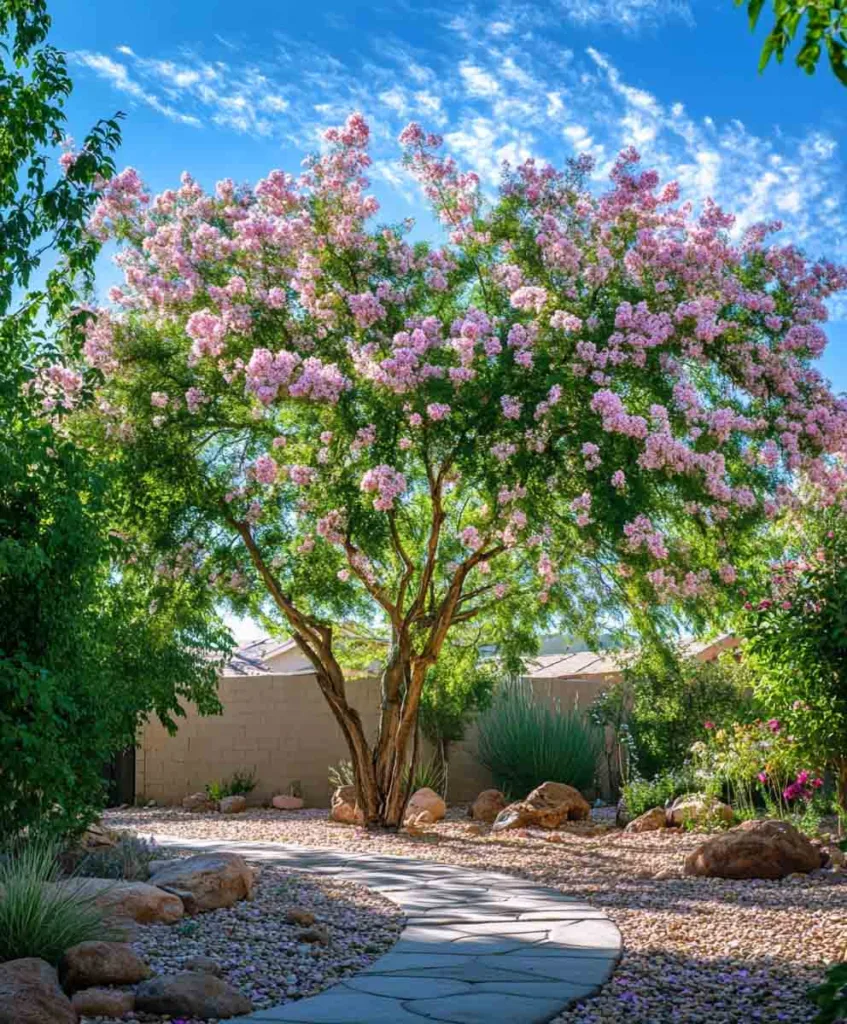
If you want tropical vibes without the water bill, Desert Willow is your gal.
Mine is right by the patio, it drops these orchid-style flowers that give off a faint sweet scent. Butterflies adore them
- Bloom Time: Late spring to fall
- Best Features:
- Thrives in full sun and poor soil
- Drought-tolerant once established
- Attracts hummingbirds and bees
- Pro Tip: Prune lightly to keep its beautiful multi-trunk shape.
3. Texas Redbud
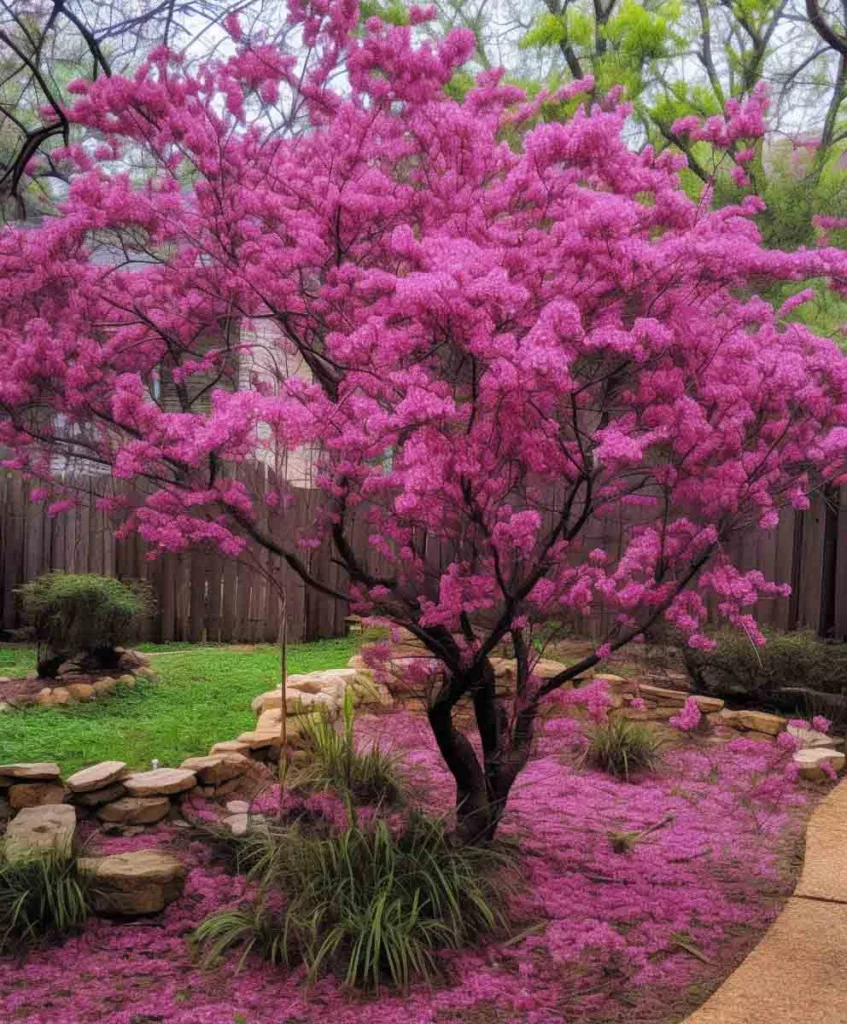
Now this one is pure Texas charm. It pops off in early spring with a shock of magenta or pink blooms that cover every branch.
It’s one of the first to bloom after winter, and honestly, it’s like the tree version of a pep talk.
- Bloom Time: Late winter to early spring
- Best Features:
- Compact, perfect for small yards
- Native and low-maintenance
- Striking heart-shaped leaves
- Planting Tip: Works great near fences or as a mid-height backdrop in mixed beds.
4. Mexican Plum

Let me tell you, this tree smells like spring. I’ve had friends walk by and stop just to sniff the air. The flowers are white, delicate, and super fragrant.
Plus, you get tiny edible plums that wildlife will appreciate even if you don’t.
- Bloom Time: Late winter to early spring
- Best Features:
- Gorgeous fragrance
- Tolerates poor soil
- Wildlife-friendly
- Care Tip: Keep pruning minimal to preserve its natural shape.
5. Vitex (Chaste Tree)

Also known as “Texas Lilac,” and yep, it lives up to the name. The flowers are tall spires of purple that remind me of lavender but Texas-sized.
I have two flanking my driveway, and they draw in bees like magnets.
- Bloom Time: Late spring to early fall
- Best Features:
- Super fast-growing
- Long blooming season
- Excellent pollinator plant
- Garden Tip: Works well in clusters for a bold impact.
6. Magnolia ‘Little Gem’

Okay, this one’s a personal favorite. It’s like the Southern Belle of trees, glossy green leaves, lemony white blooms, and an elegant vibe.
‘Little Gem’ is a compact version of the classic magnolia, making it yard-friendly without sacrificing drama.
- Bloom Time: Late spring through summer
- Best Features:
- Evergreen foliage
- Fragrant, creamy white flowers
- Fits smaller spaces
- Maintenance Note: Water regularly during dry spells for best blooms.
7. Anacacho Orchid Tree
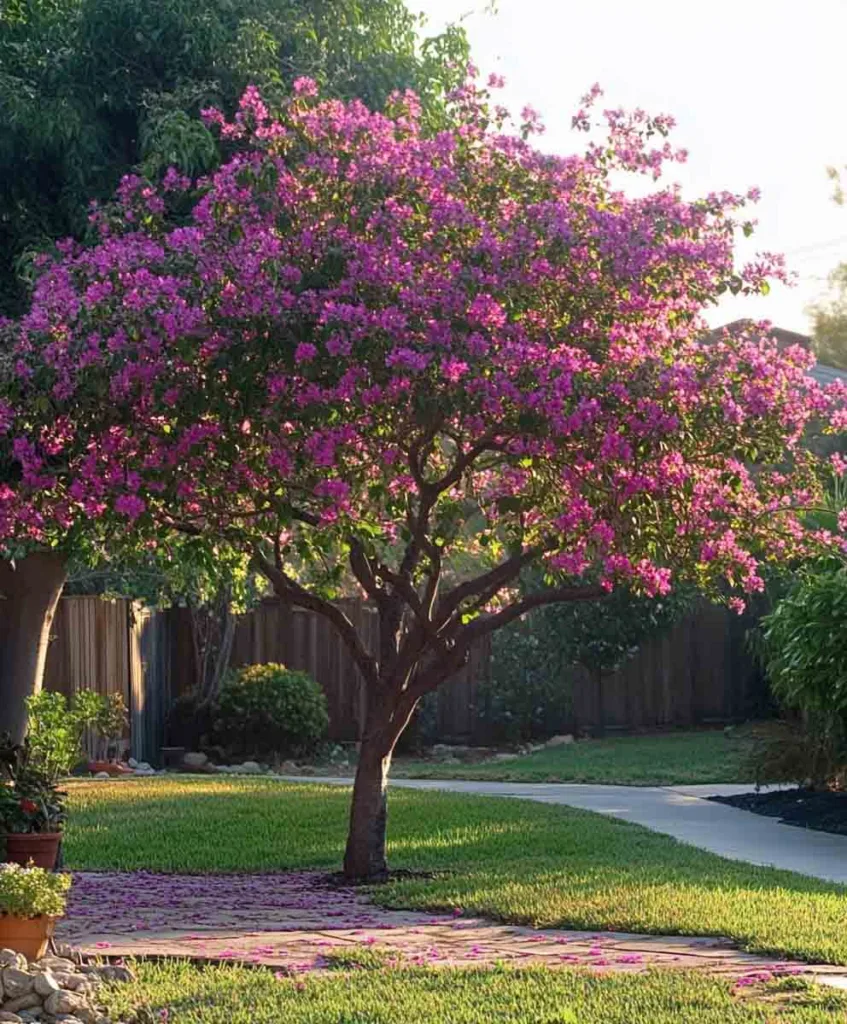
Want something a little unexpected? This tree is rare, native, and absolutely stunning when it blooms.
The pale pinkish-white flowers look like butterflies, and it’s so graceful that it often makes people stop and stare.
- Bloom Time: Spring
- Best Features:
- Unique flower shape
- Drought-tolerant
- Native to Southwest Texas
- Pro Landscaping Tip: Use it as a focal tree in minimalist gardens.
8. Coral Bean Tree
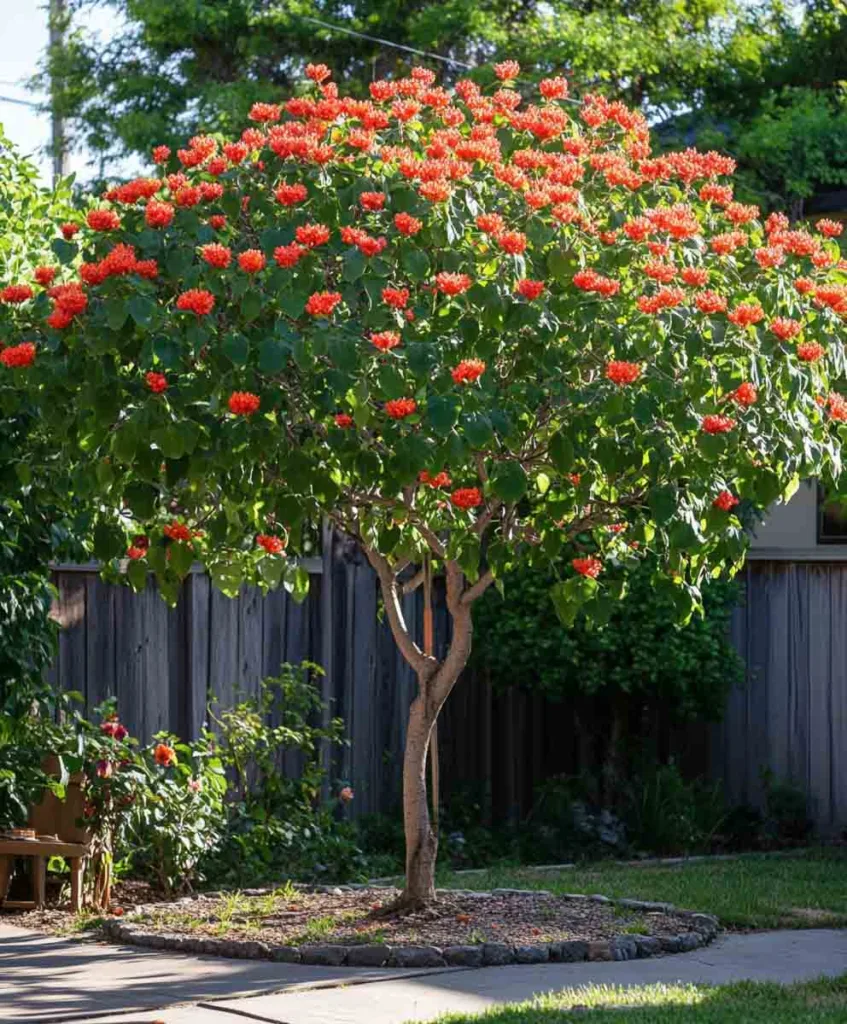
This one’s not a household name, but it deserves to be The flowers are a deep coral red that really pops against Texas greens and browns.
It’s technically a shrub, but I treat mine like a small tree. Bees, hummingbirds, and curious neighbors all love it.
- Bloom Time: Late spring to summer
- Best Features:
- Bold red blooms
- Native and hardy
- Great for butterfly gardens
- Design Tip: Combine with agaves or ornamental grasses for a bold look.
9. Eve’s Necklace
This one’s a hidden gem I fell in love with at a local nursery. The name comes from the black seed pods that look like little beads hanging from a string. But before those pods appear, you get these delicate pink, wisteria-style blooms in spring.
- Bloom Time: Mid to late spring
- Best Features:
- Graceful shape and airy texture
- Pink flower clusters are highly fragrant
- Very drought-tolerant once established
- Yard Tip: Works beautifully as a specimen tree near patios or walkways.
10. Fragrant Mimosa (Albizia julibrissin)
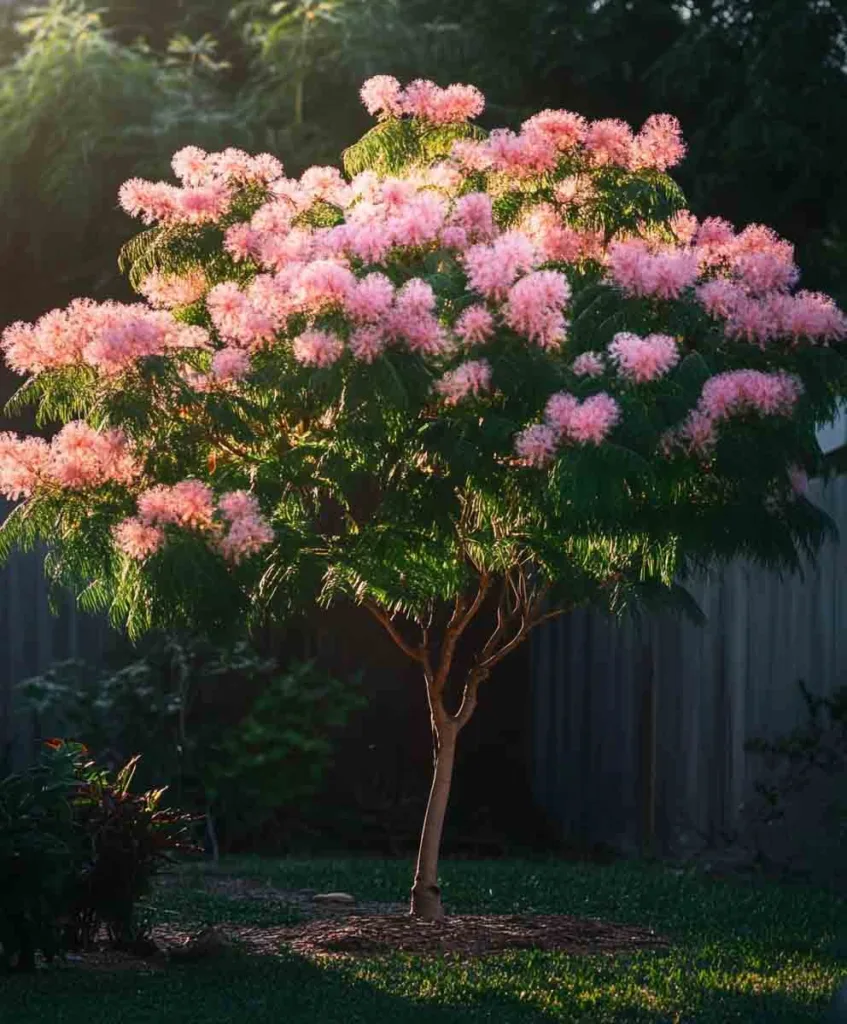
I grew up calling this a “powder puff tree” because of its fluffy pink flowers that look like little fireworks. It’s soft, exotic, and the scent reminds me of my grandma’s garden.
- Bloom Time: Summer
- Best Features:
- Graceful fern-like leaves
- Attracts bees, butterflies, and hummingbirds
- Fragrant and feathery flowers
- Garden Tip: Be sure to give it room to spread—its canopy loves to stretch out.
11. Texas Mountain Laurel
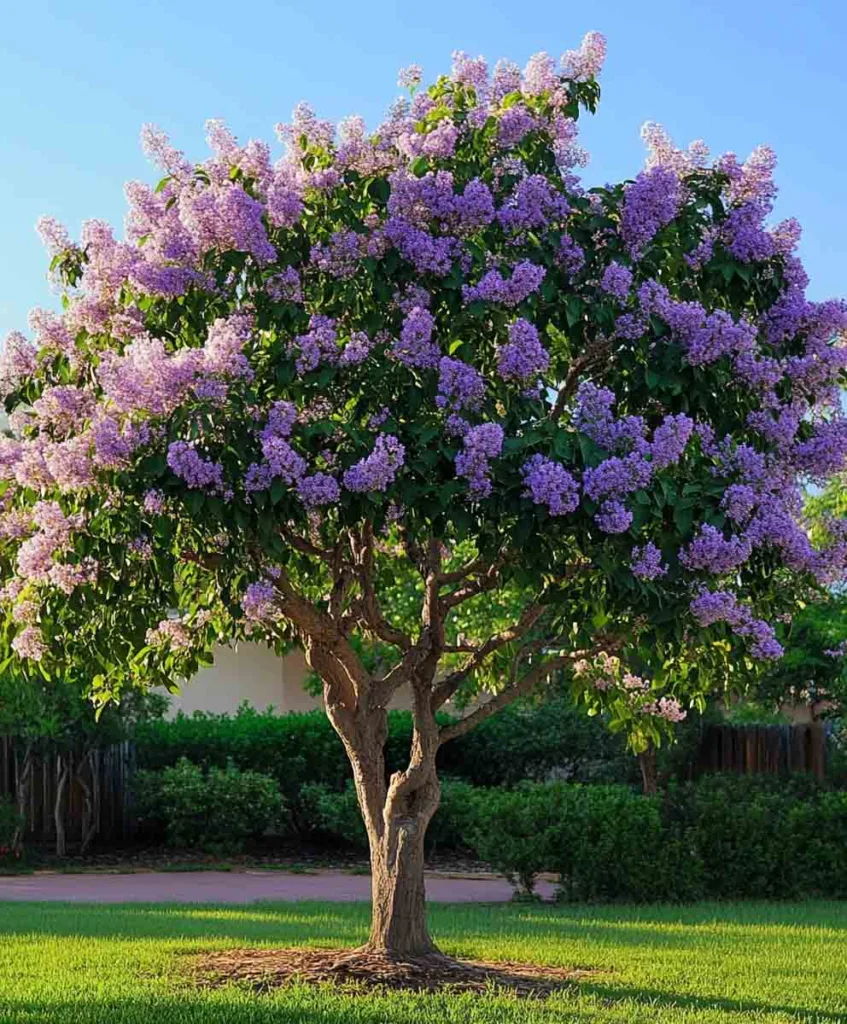
You know that grape soda smell in spring? That’s this tree. It’s one of the most iconic natives you can add to your yard, and it packs a punch with deep purple flower clusters that are both tough and beautiful.
- Bloom Time: Early spring
- Best Features:
- Evergreen with leathery leaves
- Drought-tolerant and slow-growing
- Strong, sweet grape-like fragrance
- Planting Tip: Great for xeriscaping or rocky landscapes.
12. Chinese Fringe Tree
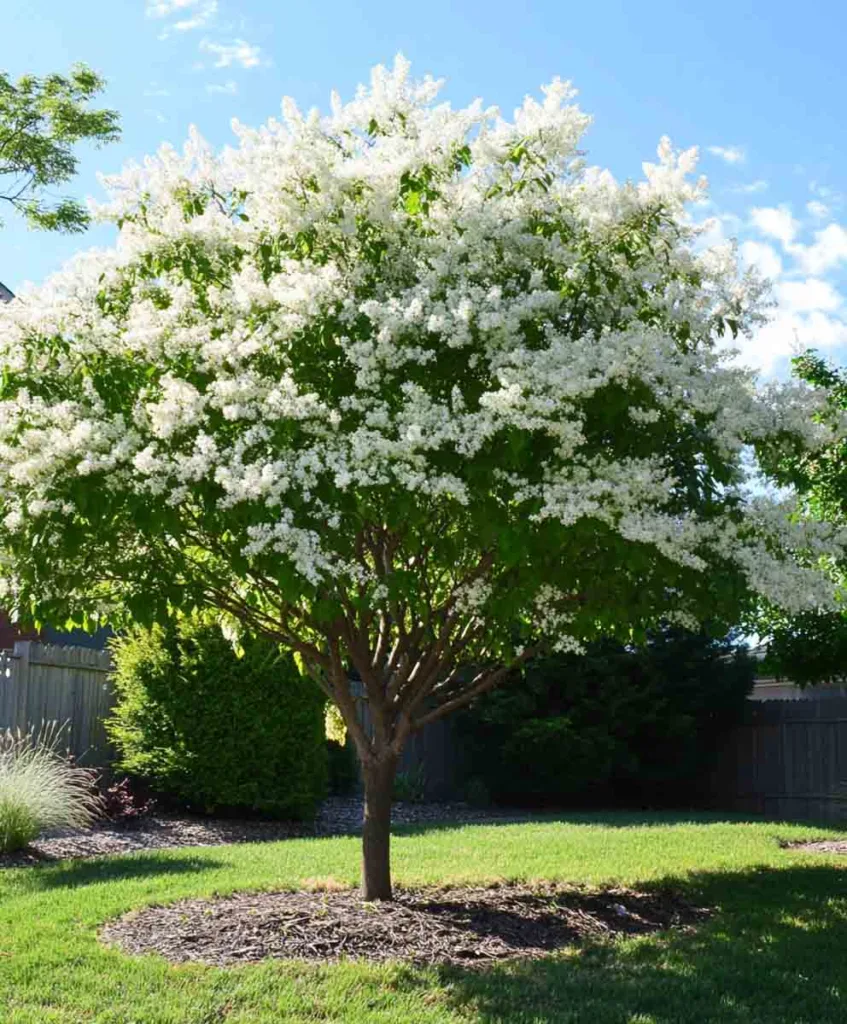
This one really steals the show in spring with cloud-like white blooms that dangle like fringe. It looks soft and romantic, but don’t be fooled—it handles Texas weather like a champ.
- Bloom Time: Mid to late spring
- Best Features:
- Tolerates poor soil and urban conditions
- Moderate size, ideal for smaller yards
- Fragrant white flowers in fringe-like clusters
- Design Tip: Plant near a window or entrance to enjoy the springtime scent.
13. Golden Rain Tree
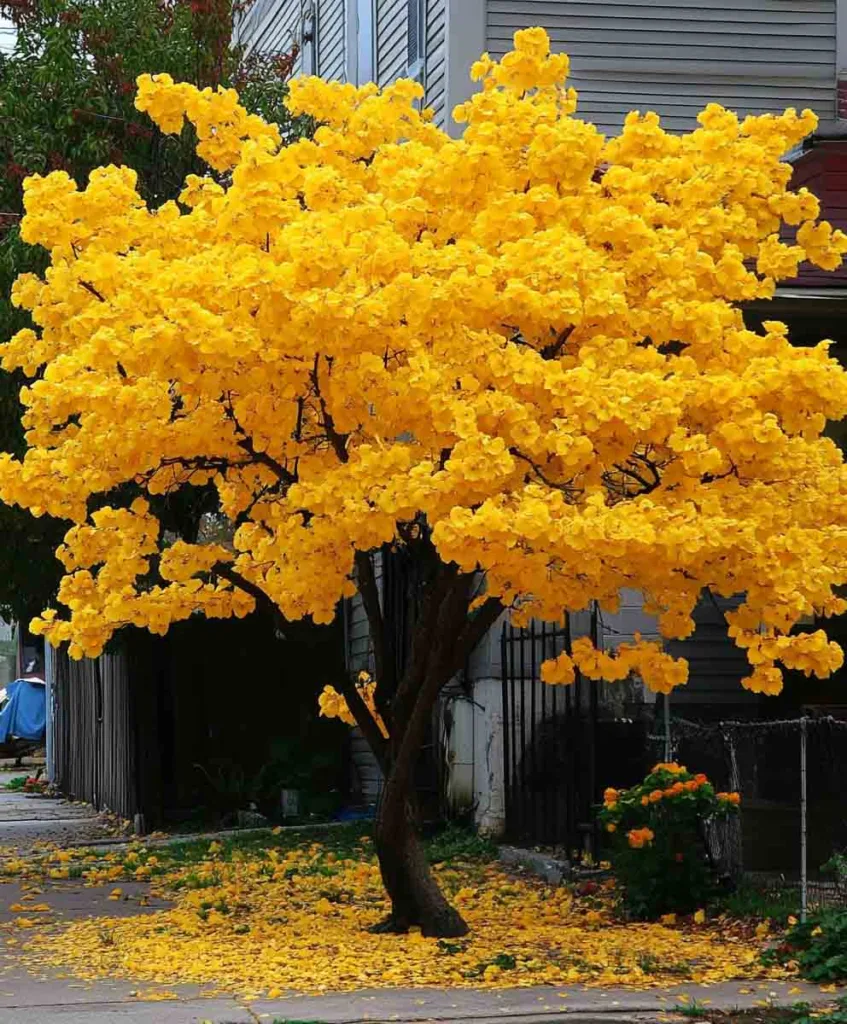
It’s not just the name—it literally rains gold when those yellow blooms start falling. I planted one near my back gate, and it makes even the dry months feel like a celebration.
- Bloom Time: Early summer
- Best Features:
- Bright yellow flower panicles
- Adaptable to different soils
- Unique lantern-shaped seed pods
- Fun Idea: Collect fallen seed pods for DIY crafts or dry arrangements.
14. Western Soapberry
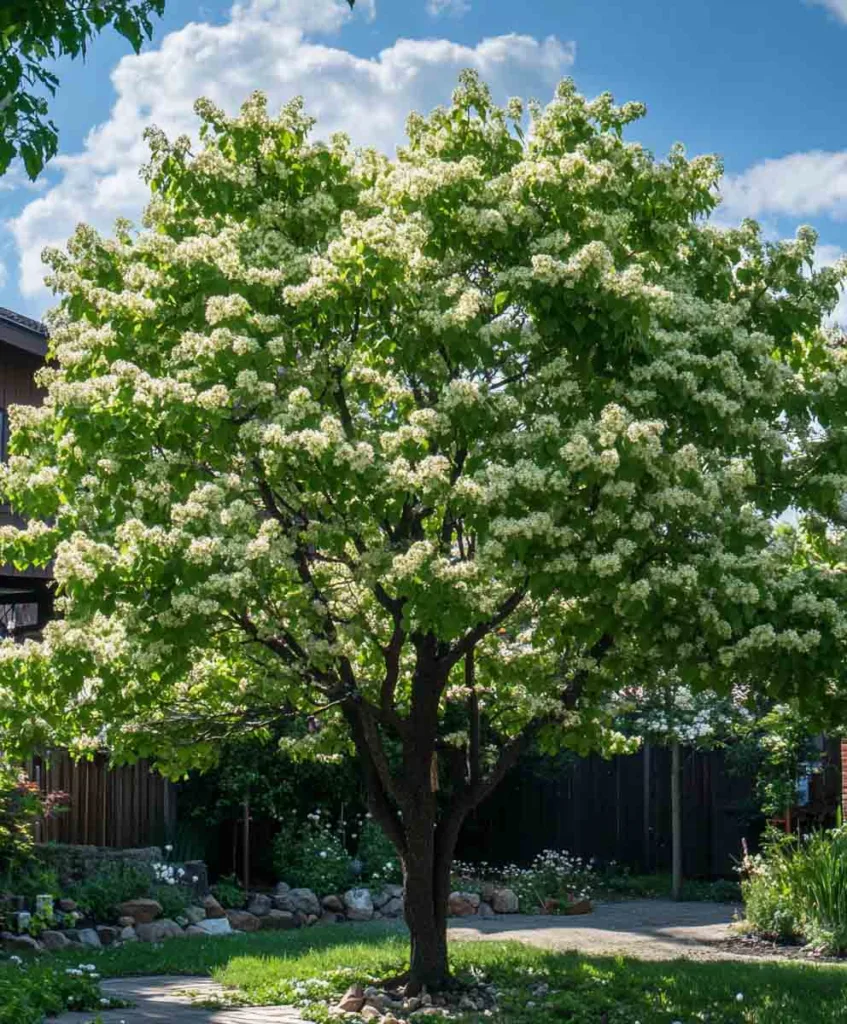
This one doesn’t get enough love, but I highly recommend it if you want a low-fuss native with plenty of visual interest. The creamy-yellow blooms are modest, but the amber-yellow berries and fall foliage make up for it.
- Bloom Time: Late spring
- Best Features:
- Hardy native species
- Glossy green leaves that turn golden in fall
- Resistant to most pests and diseases
- Note: The berries are not edible, so keep pets away from fallen fruit.
15. Japanese Snowbell
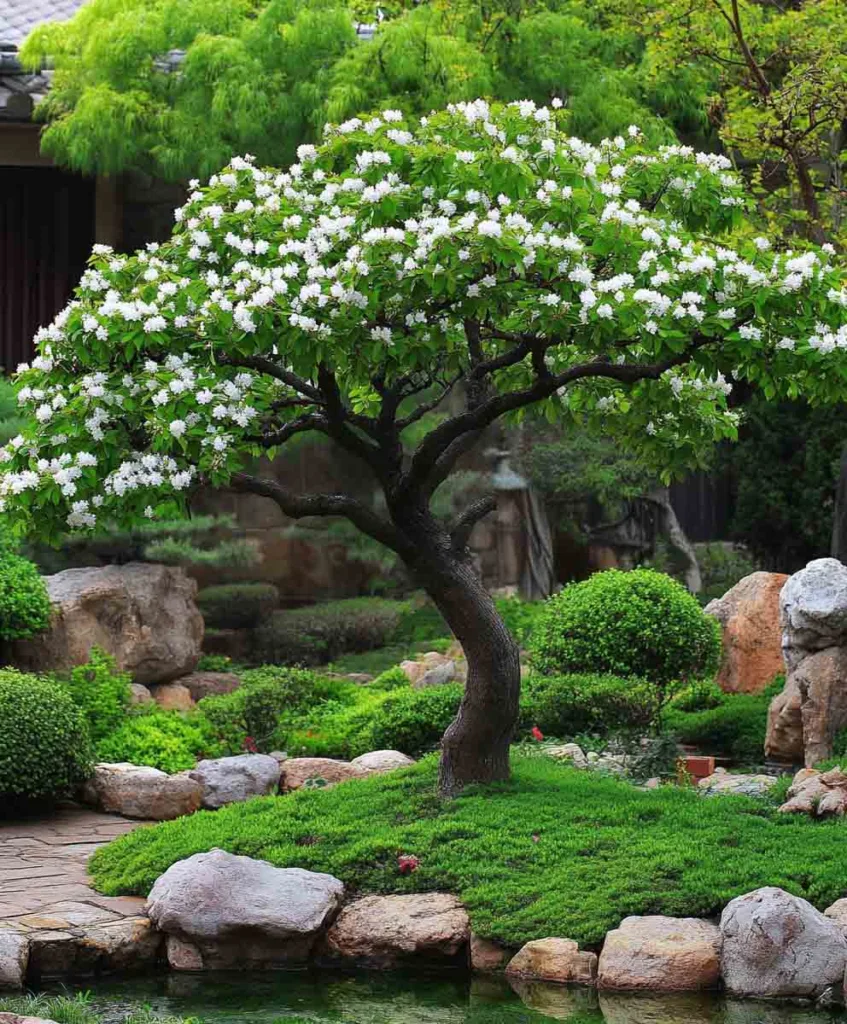
The name alone made me want one—and it didn’t disappoint. Imagine small white bell-shaped flowers dangling beneath the branches like earrings. It’s subtle, graceful, and smells so clean and sweet.
- Bloom Time: Late spring to early summer
- Best Features:
- Elegant form and light fragrance
- Perfect for shaded yards or courtyards
- Blooms hang beneath the branches
- Tip: Works beautifully near seating areas or water features.
16. Mexican Buckeye
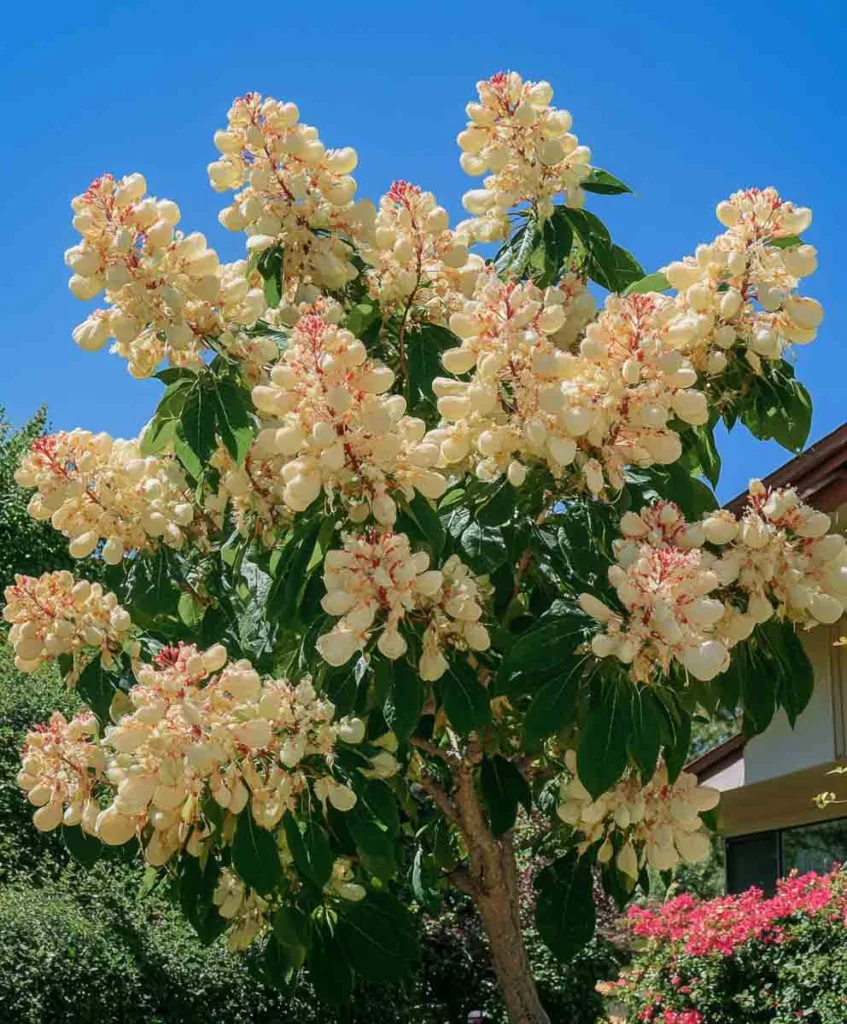
This one is super easy to love. It gives you showy pink blooms in early spring, followed by decorative seed pods that rattle in the wind—super cool for kids or curious guests.
- Bloom Time: Early spring
- Best Features:
- Bright pink flowers before the leaves emerge
- Tolerates drought and heat
- Light shade provider with rounded crown
- Yard Use: Ideal for rock gardens, borders, or as a standalone focal point.
17. Purple Robe Locust
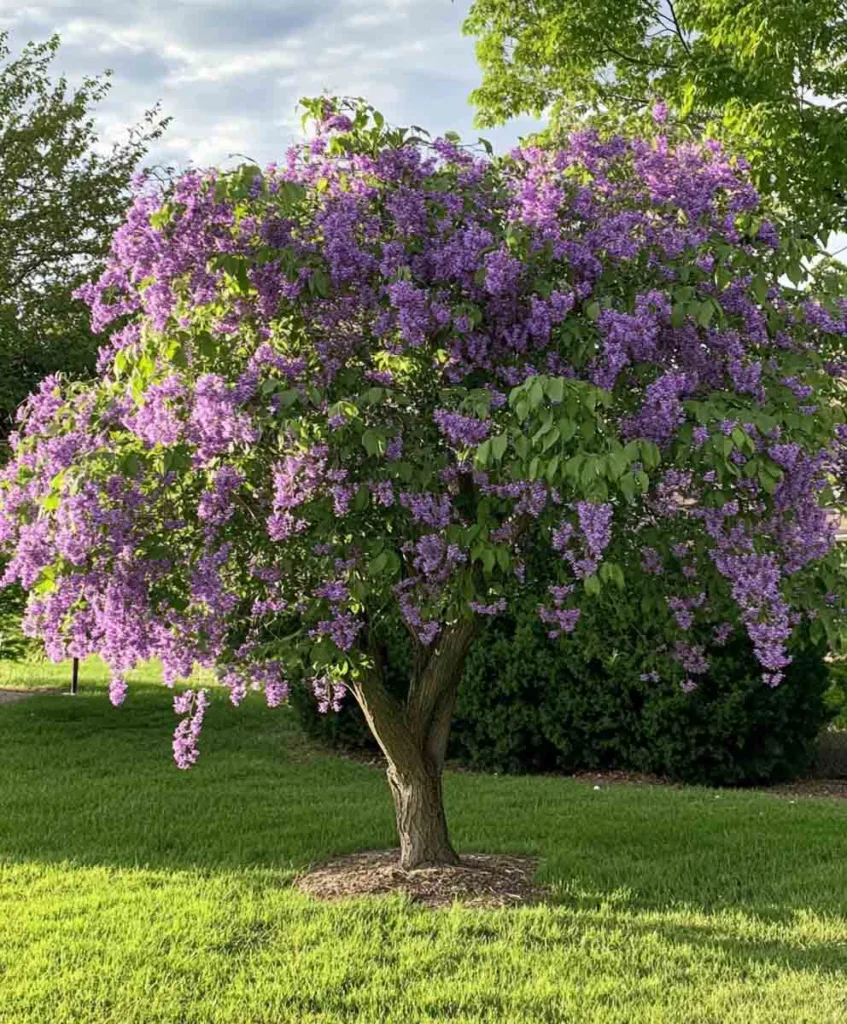
You want something fast-growing and dramatic? Go with this one. The purple-pink wisteria-like blooms make a bold entrance in spring and early summer. It thrives in harsh conditions, too.
- Bloom Time: Spring
- Best Features:
- Gorgeous cascades of violet flowers
- Tolerates poor soil and heat
- Fragrant and fast-growing
- Caution: It can spread aggressively in the right conditions, so stay on top of pruning.
18. Silk Tree (Persian Silk Tree)
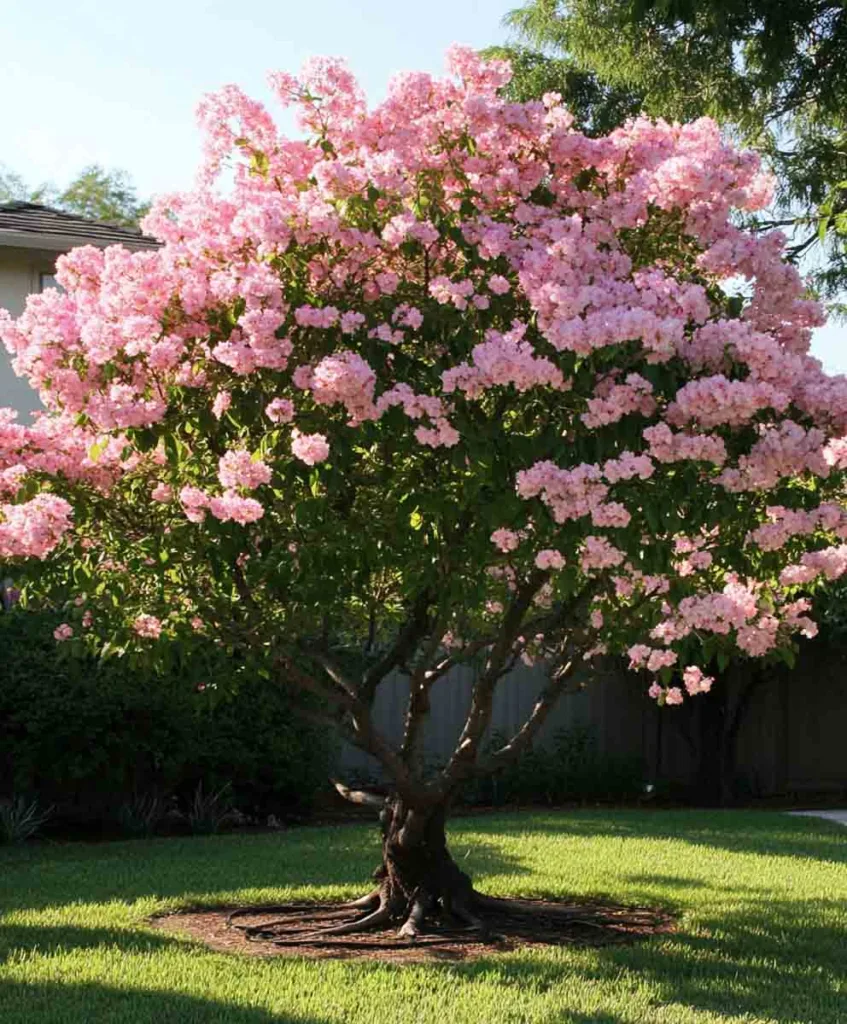
This one has a tropical vibe with almost zero effort. Soft pink blooms that look like tassels float above the tree like confetti. Kids always call it “the fuzzy tree,” and honestly, they’re not wrong.
- Bloom Time: Late spring to summer
- Best Features:
- Airy canopy with soft-textured leaves
- Ideal for shaded lounging spaces
- Unique pink puffball flowers
- Bonus: Makes a lovely habitat for butterflies and songbirds.
Frequently Asked Questions
What is the best time to plant flowering trees in Texas?
The best time is late fall through early spring, when the weather is cooler and gives the roots a chance to establish before the brutal summer hits.
Are these flowering trees safe around pets?
Most of them are safe, but it’s always good to double-check specific trees like Magnolia or Coral Bean, as parts can be mildly toxic if ingested.
How often should I water my flowering trees?
New trees need regular watering until established (around 1 year). After that, most can survive on rainwater or bi-weekly watering, especially native species.
Do flowering trees attract pests?
They can, but most of these trees are pretty pest-resistant. Just keep an eye out for aphids or caterpillars in spring and treat with neem oil if needed.
Can I grow these trees in containers?
Only a few, like Desert Willow or Vitex, will tolerate containers when young, but they’re best suited for ground planting if you want long-term growth.
Wrapping It All Up
Texas heat is no joke, but that doesn’t mean your yard has to be boring or barren. These flowering trees bring color, life, and personality to any yard, from sprawling estates to tiny urban plots.
Pick a couple of these beauties, plant them right, and you’ll have a yard full of blooms, bees, and shade before you know it. I promise, your future self (and your neighbors) will thank you
Let me know if you end up planting any of these, I love hearing about what works in different Texas zones.

